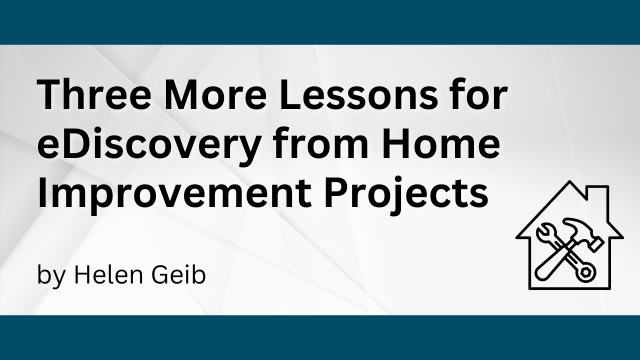
[EDRM Editor’s Note: The opinions and positions are those of Helen Geib. This article is the second in a two-part series drawing parallels between home improvement projects and the practice of eDiscovery. You can read Part One here.]
When people say that your life experiences can make you a better lawyer they’re usually talking about empathy. I went in a different direction and applied lessons learned from home improvement to eDiscovery practice. In part one, I covered five things to do during project set-up. Here are three more lessons for different stages of the eDiscovery workflow.
6. The lowest bid isn’t necessarily the most cost-effective option.
Home improvement projects require you to make lots of decisions about materials, designs and colors. There’s a bewildering array of choices, to say nothing of the eye-popping prices. It takes time and effort to evaluate all the relevant factors like cost, durability, warranty, customer reviews and aesthetics. It’s tempting to simply compare prices and default to the lowest bid. As many have discovered to their regret, this is usually a false economy.
It’s tempting to simply compare prices and default to the lowest bid. As many have discovered to their regret, this is usually a false economy.
Helen Geib, Hoover Hull Turner LLP.
While decision fatigue isn’t a big problem in eDiscovery, sticker shock is another matter. Nonetheless, just like when it comes time to choose the more expensive but longer-lasting outdoor paint, it’s important to make your purchasing decisions based on the overall value proposition and not solely on up-front cost.
As a practical tip, instead of focusing immediately on price, start by identifying software and service options that meet the needs of your project. Once you have a shortlist of suitable options you’ll be able to make a meaningful price comparison.
7. Waiting is built into the eDiscovery lifecycle.
My house still has its original 1938 windows. If you’ve lived in an old house, then you know that means broken sash cords. You can’t replace the ropes without partially dismantling the wood frame. That meant I had to keep putting off the painter until I found a handyman with the right skillset to make the window repairs.
The document reviewers are the painting company in this analogy. They want to get going, yet it’s a waiting game. This can cause friction within the project team.
What’s under our control is how we manage the waiting. If you’re to the left of the review stage, be proactive about giving time estimates (you can hedge with caveats and ranges), status updates and completion notifications.
What’s under our control is how we manage the waiting. If you’re to the left of the review stage, be proactive about giving time estimates (you can hedge with caveats and ranges), status updates and completion notifications.
Helen Geib, Hoover Hull Turner LLP.
If you’re a reviewer, use the time productively to prepare for the eyes-on part of the review. Depending on your role this might include any of studying the pleadings, discovery requests and key documents provided by the client; creating a review workflow; discussing issue tags; and participating in a review kick-off meeting. Finally, the waiting period is an opportune time to clear your schedule by finishing up tasks for other cases.
8. Quality control is non-negotiable.
When I got a new roof the last step in the process was a quality inspection by a project manager. While I could have gone up there myself (if I didn’t have a fear of heights) I wouldn’t have known what to look for. After I got the manager’s okay is when I mailed the check.
Quality control, or QC in legal industry-speak, is also non-negotiable in an eDiscovery project. Unlike my roof inspection, but like most things in eDiscovery, QC is a collaborative exercise. It’s explicitly part of some job descriptions, notably in project management, and we all contribute by carefully checking our work.
Quality control, or QC in legal industry-speak, is also non-negotiable in an eDiscovery project. Unlike my roof inspection, but like most things in eDiscovery, QC is a collaborative exercise. It’s explicitly part of some job descriptions, notably in project management, and we all contribute by carefully checking our work.
Helen Geib, Hoover Hull Turner LLP.
During the time I was writing this article a truck turning into the alley behind my house clipped the corner of the garage roof. It was a reminder that a homeowner’s work is never done. Likewise, there’s always something new to learn in eDiscovery. Some lessons come from unexpected places.
Assisted by GAI and LLM Technologies per EDRM GAI and LLM Policy.


